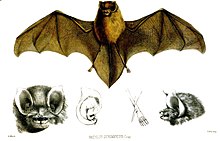Hispaniolan greater funnel-eared bat
| Hispaniolan greater funnel-eared bat | |
|---|---|
| Scientific classification | |
| Domain: | Eukaryota |
| Kingdom: | Animalia |
| Phylum: | Chordata |
| Class: | Mammalia |
| Order: | Chiroptera |
| Family: | Natalidae |
| Genus: | Natalus |
| Species: | N. major
|
| Binomial name | |
| Natalus major (Miller, 1902)
| |

| |
The Hispaniolan greater funnel-eared bat (Natalus major) is a
Taxonomy
The Hispaniolan greater funnel-eared bat was first described scientifically in 1902 by
The genus Natalus was traditionally placed into three subgenera: Natalus, Chilonatalus and Nyctielleus.
Description

The Hispaniolan greater funnel-eared bat is similar in appearance to a larger version of the Mexican funnel-eared bat (Natalus stramineus).[7] The two species have such similar morphology that in his original description of the Hispaniolan greater funnel-eared bat, Miller declined to offer a description of its physical appearance, writing "Except for its greater size, Natalus major so closely resembles specimens of N. stramineus from Dominica as to require no detailed description."[3]
The Hispaniolan greater funnel-eared bat has a forearm length of between 40 and 45 millimetres (1.6 and 1.8 in).[7] The fur covering the body of the species is soft and moderately long, with a wool-like texture at the base. The upperparts are tawny-olive, while the underparts, and the base of the hairs, are pink-buff. The membranes on the wing are umber. The large natalid organ (the structure located on the forehead) is bell-shaped. No sexual dimorphism is apparent.[7]
Distribution, habitat and ecology
The species is found widely[1] throughout the island of Hispaniola, in both the Dominican Republic and Haiti.[4] Previous reports of the species from Jamaica[7] and other islands are now recognised as records of separate species.[11] For the most part, the species is found in caves, though a record from a hollow tree is also known. Due to the delicate wing membrane, it is assumed that the species requires relatively humid caves for daytime roosting.[1]
The Hispaniolan greater funnel-eared bat is insectivorous,[1] like all members of its genus.[11] Individuals are assumed to forage in dense vegetation over a limited range near their preferred roost. No information on reproduction is known.[1]
Conservation status
The
References
- ^ . Retrieved 22 September 2021.
- OCLC 62265494.
- ^ JSTOR 4062747.
- ^ a b c Tejedor, Tavares and Silva-Taboada 2005, p. 4.
- ^ Tejedor, Tavares and Silva-Taboada 2005, p. 21.
- hdl:2246/1358.
- ^ JSTOR 3503782. Archived from the original(PDF) on 2014-05-12. Retrieved 2013-06-19.
- . Retrieved 22 September 2021.
- ^ Goodwin, George G. (1959). "Bats of the subgenus Natalus" (PDF). American Museum Novitates (1977): 1–22.
- . Retrieved 22 September 2021.
- ^ a b c d e Tejedor, Tavares and Silva-Taboada 2005, p. 2.
- hdl:2246/2001.
- ^ a b Tejedor, Tavares and Silva-Taboada 2005, p. 3.
- ^ Genoways, Hugh H.; Timm, Robert R.; Baker, Robert J.; Phillips, Carleton J.; Schlitter, Duane A. (2001). "Bats of the West Indian island of Dominica: Natural history, areography, and trophic structure". Museum of Texas Tech University Special Publications. 43: 1–43.
Cited texts
- Tejedor, Adrian; Tavares, Valeria da C. & Silva-Taboada, Andgilberto (2005). "A revision of extant Greater Antillean bats of the genus Natalus" (PDF). American Museum Novitates (3493): 1–22. S2CID 54911652.

